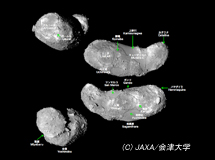Naming of Geological Features of the Asteroid "Itokawa" Based on a Journal Paper Including Faculty Members from the University of Aizu
Nomenclature proposals for geological features on the surface of the asteroid "Itokawa" were officially approved
by the International Astronomical Union (IAU). Itokawa was observed by the spacecraft "HAYABUSA,"
and the University of Aizu has contributed to this HAYABUSA project.
Assistant Professor Naru Hirata and Assistant Professor Hirohide Demura of the Multimedia Systems Laboratory and
their co-researchers analyzed observation data from HAYABUSA and researched Itokawa's surface.
Based on research achievements published in the scientific journal "Icarus" (Primary author: Naru Hirata),
the IAU approved names for 10 craters and 4 regions of Itokawa and officially accepted to use of names.
The HAYABUSA project team discussed the nomenclature proposals for the surface of Itokawa based on Assistant Professor Hirata's
research paper and then submitted the proposals to IAU. The team received advice from Associate Professor Junichi
Watanabe of the National Astronomical Observatory of Japan, who is from Aizu, during this process.
Clear definitions which can withstand standards for refereed scientific journals are necessary for nomenclature of
celestial bodies. The research paper written by Assistant Professor Hirata et al. revealed crater existence and
other characteristics of terrain on Itokawa surfaces that made it possible to approve the nomenclature proposal.
Their research published in a journal revealed sizes, distributions and geological characteristics of impact craters on Itokawa,
which were based on analyses of images sent by HAYABUSA and models created based on those images using shope-modeling technology
of the University. Compared to impact craters on the moon which are fairly typical example of craters, impact craters
on Itokawa were extremely shallow and many of them showed irregular circles. The results of this research on the crater characteristics
provide an important key to finding information on the origin, evolution and internal structure of Itokawa.
- Click on the image to get a larger image and for an explanatioin on the names and their origins.
[Related articles]
- JAXA Press Release (Only in Japanese)
- JAXA Institute of Space and Astronautical Science Topics (Only in Japanese)
- ※ A research paper published in "Icarus"
- "A survey of possible impact structures on 25143 Itokawa"
- Naru Hirata, Olivier S. Barnouin-Jha, Chikatoshi Honda, Ryosuke Nakamura, Hideaki Miyamoto, Sho Sasaki, Hirohide Demura, Akiko M. Nakamura, Tatsuhiro Michikami, Robert W. Gaskell, and Jun Saito
- * Names of celestial bodies within the Solar System
- The United States Geological Survey (USGS) Astrogeology Research Group has compiled a list of names of celestial bodies within the Solar System based on IAU decisions. Click on the following link to see a list of names of geological features of Itokawa.
- http://planetarynames.wr.usgs.gov/jsp/FeatureTypes2.jsp?system=Asteroid%20Belt&body=Itokawa&systemID=12&bodyID=67&sort=AName&show=Fname&show=Lat&show=Long&show=Diam&show=Stat&show=Orig
- * The International Astronomical Union (IAU)
- IAU is an international academic society that unites astronomers in the world to study space and acts as recognized authority for assigning name designations to celestial bodies such as stars, planets, asteroids, etc. IAU came to world attention in 2006 when it defined the term "planet" and classified Pluto into a new category of dwarf planets.
- * Icarus
- This academic journal was founded in 1962 and is published by the American Astronomical Society's Division for Planetary Science (DPS). It is known as one of the most authoritative journals on planetary science and contains articles regarding observations, experiments, theories and other scientific aspects of the Solar System. The late Carl Sagan, who was an advisor to NASA on planetary exploration, served as editor of the journal.
The University of Aizu "HAYABUSA" project team has made significant contributions to lunar/planetary explorations through terrain analysis using observation data from space. Please click on the following links to view articles on past research achievements made by the team.
